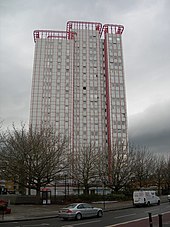|
Lightening holes Lightening holes are holes in structural components of machines and buildings used by a variety of engineering disciplines to make structures lighter. The edges of the hole may be flanged to increase the rigidity and strength of the component.[1] The holes can be circular, triangular, elliptical, or rectangular and should have rounded edges, but they should never have sharp corners, to avoid the risk of stress risers, and they must not be too close to the edge of a structural component.[2][3] UsageAviation Lightening holes are often used in the aviation industry. This allows the aircraft to be lightweight as possible, retaining the durability and airworthiness of the aircraft structure.[4][5] MaritimeLightening holes have also been used in marine engineering to increase seaworthiness of the vessel.[6][7][8] Motorsports Lightening holes became a prominent feature of motor racing in the 1920s and 1930s. Chassis members, suspension components, engine housings and even connecting rods were drilled with a range of holes, of sizes almost as large as the component.
MilitaryLightening holes have been used in various military vehicles, aircraft, equipment and weaponry platforms.[citation needed] This allows equipment to be lighter in weight as well as increase the ruggedness and durability.[citation needed] They are usually made by drilling[citation needed] holes, pressed stamping or machining and can also save strategic materials and cost during wartime production. Architecture Lightening holes have been used on various architecture designs.[10] During the 1980s and early 1990s, lightening holes were fashionable and somewhat seen as futuristic and were used in the likes of industrial units, car showrooms, shopping precincts, sports centres etc. Parsons House in London is a notable building that uses lightening holes since its renovation in 1988.[11][12] Ringwood Health & Leisure Centre in Hampshire is another notable example.[13][14] See alsoReferences
External linksWikimedia Commons has media related to Lightening holes.
|